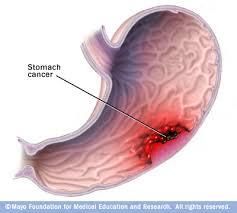

Digestive Health
Dr Saravana.K
Stomach cancer occurs in the stomach – the muscular sac located in the upper middle of your abdomen, just below your ribs. Your stomach receives and holds the food you eat and then helps to break down and digest it. Types of stomach cancer include:
- Adenocarcinoma: begins in the glandular cells – most common
- Lymphoma: begins in immune system cells
- Carcinoid: begins in hormone-producing cells
- Gastrointestinal stromal tumour (GIST): begins in nervous system tissues.
Symptoms
Fatigue; feeling bloated; heartburn and indigestion; nausea and vomiting; stomach pain and weight loss that is unintentional.
Causes
Doctors aren’t sure what causes stomach cancer. There is a strong correlation between a diet high in smoked, salted and pickled foods and stomach cancer
Risk factors
Factors that increase your risk of stomach cancer include: a diet high in salty and smoked foods; a diet low in fruits and vegetables; eating foods contaminated with aflatoxin fungus; family history of stomach cancer; infection with Helicobacter pylori; long-term stomach inflammation; pernicious anemia; smoking; stomach polyps.
Tests and procedures used to diagnose stomach cancer include:
- A tiny camera to see inside your stomach (upper endoscopy). A thin tube containing a tiny camera is passed down your throat and into your stomach. Your doctor can look for signs of cancer. If any suspicious areas are found, a piece of tissue can be collected for analysis (biopsy).
- Imaging tests. Imaging tests used to look for stomach cancer include (CT) scan.
Determining the extent (stage) of stomach cancer
The stage of your stomach cancer helps your doctor decide which treatments may be best for you. Tests and procedures used to determine the stage of cancer include:
- Imaging tests. CT and positron emission tomography (PET).
- Exploratory surgery. Your doctor may recommend surgery to look for signs that your cancer has spread beyond your stomach within your abdomen. Exploratory surgery is usually done laparoscopically. This means the surgeon makes several small incisions in your abdomen and inserts a special camera that transmits images to a monitor in the operating room.
- Other staging tests may be used, depending on your situation.
- Your treatment options for stomach cancer depend on the stage of your cancer, your overall health and your preferences.
Surgery
The goal of surgery is to remove all of the stomach cancer and a margin of healthy tissue, when possible. Options include:
- Removing early-stage tumours from the stomach lining. Very small cancers limited to the inside lining of the stomach may be removed using endoscopy in a procedure called endoscopic mucosal resection. The endoscope is a lighted tube with a camera that’s passed down your throat into your stomach. The doctor uses special tools to remove the cancer and a margin of healthy tissue from the stomach lining.
- Removing a portion of the stomach (subtotal gastrectomy).
- Removing the entire stomach (total gastrectomy). Removing lymph nodes to look for cancer.
- Removing part of the stomach may relieve signs and symptoms of a growing tumour in people with advanced stomach cancer. In this case, surgery can’t cure advanced stomach cancer, but it can make you more comfortable.
Radiation therapy can be used before surgery to shrink a stomach tumour so that it’s more easily removed. Radiation therapy can also be used after to kill any cancer cells that might remain around your stomach. Radiation is often combined with chemotherapy. In cases of advanced cancer, radiation therapy may be used to relieve side effects caused by a large tumour.






